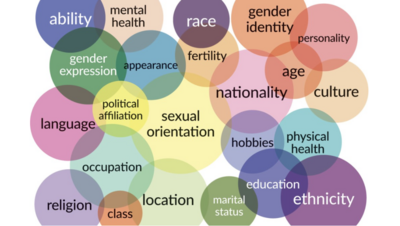Intersectionality: Difference between revisions
No edit summary |
No edit summary |
||
| (One intermediate revision by the same user not shown) | |||
| Line 5: | Line 5: | ||
<span style=""></span> | <span style=""></span> | ||
<p>Intersectionality is an ''"analytical angle that provides a non-hierarchical understanding <span style="">of power dynamics and oppression(s), especially when observed simultaneously." </span>''<span style="">- Lourdenie Jean <ref>https://lenvironnementcestintersectionnel.com</ref> </span></p> | <p>Intersectionality is an ''"analytical angle that provides a non-hierarchical understanding <span style="">of power dynamics and oppression(s), especially when observed simultaneously." </span>''<span style="">- Lourdenie Jean <ref>https://lenvironnementcestintersectionnel.com</ref> </span></p> | ||
<p><span style="">The diagram that follows mentions a few of the identifying factors where people may face systems of oppression.</span></p> | |||
<sup class="reference"></sup><p><sup id="cite_ref-1" class="reference"></sup><sup id="cite_ref-1" class="reference"></sup></p> | <sup class="reference"></sup><p><sup id="cite_ref-1" class="reference"></sup><sup id="cite_ref-1" class="reference"></sup></p> | ||
| Line 12: | Line 13: | ||
<p><span style=""></span></p> | <p><span style=""></span></p> | ||
[[File:Screen Shot 2022-09-01 at 11.28.38 AM.png|400px|center|border|Intersectionality Diagram by Misty McPhetridge, BSSW]] | [[File:Screen Shot 2022-09-01 at 11.28.38 AM.png|400px|center|border|Intersectionality Diagram by Misty McPhetridge, BSSW]] | ||
<p><br><span>"''I''</span>''<span>ntersectionality refers to a transdisciplinary theory aimed at understanding the complexity of identities and social inequalities through an integrated approach. </span><span>It refutes the partitioning and the hierarchization of the main axes of social differentiation which are the categories of [...] gender, class, race, ethnicity, age, handicap and sexual orientation. </span><span>The intersectional approach goes beyond a simple recognition of the multiplicity of systems of oppression operating from these categories and postulates their interaction in the production and reproduction of social inequalities (Crenshaw 1989; Collins 2000; Brah & Phoenix 2004)."</span>''<span> - Sirma Bilge <ref> https://doi.org/10.3917/dio.225/0070</ref> </span></p> | <p><br><span>"''I''</span>''<span>ntersectionality refers to a transdisciplinary theory aimed at understanding the complexity of identities and social inequalities through an integrated approach. </span><span>It refutes the partitioning and the hierarchization of the main axes of social differentiation which are the categories of [...] gender, class, race, ethnicity, age, handicap and sexual orientation. </span><span>The intersectional approach goes beyond a simple recognition of the multiplicity of systems of oppression operating from these categories and postulates their interaction in the production and reproduction of social inequalities (Crenshaw 1989; Collins 2000; Brah & Phoenix 2004)."</span>''<span> - Sirma Bilge <ref> https://doi.org/10.3917/dio.225/0070</ref> </span></p> | ||
<p> <br></p> | <p> <br></p> | ||
The following video includes Crenshaw discussing the concept of Intersectionality, how it manifests, and why addressing injustice using an intersectional lens is so critical. | The following video includes Crenshaw discussing the concept of Intersectionality, how it manifests, and why addressing injustice using an intersectional lens is so critical. | ||
Latest revision as of 16:51, 26 October 2022
Coined by Kimberle Crenshaw, intersectionality is "a lens, a prism, for seeing the way in which various forms of inequality often operate together and exacerbate each other. We tend to talk about race inequality as separate from inequality based on gender, class, sexuality or immigrant status. What’s often missing is how some people are subject to all of these, and the experience is not just the sum of its parts." -Kimberle Crenshaw [1]
Intersectionality is an "analytical angle that provides a non-hierarchical understanding of power dynamics and oppression(s), especially when observed simultaneously." - Lourdenie Jean [2]
The diagram that follows mentions a few of the identifying factors where people may face systems of oppression.
Intersectionality Diagram by Misty McPhetridge, BSSW

"Intersectionality refers to a transdisciplinary theory aimed at understanding the complexity of identities and social inequalities through an integrated approach. It refutes the partitioning and the hierarchization of the main axes of social differentiation which are the categories of [...] gender, class, race, ethnicity, age, handicap and sexual orientation. The intersectional approach goes beyond a simple recognition of the multiplicity of systems of oppression operating from these categories and postulates their interaction in the production and reproduction of social inequalities (Crenshaw 1989; Collins 2000; Brah & Phoenix 2004)." - Sirma Bilge [3]
The following video includes Crenshaw discussing the concept of Intersectionality, how it manifests, and why addressing injustice using an intersectional lens is so critical.
If you have any suggested revisions or additional resources to share related to the above content, please email them to kenzie@lehub.ca.
